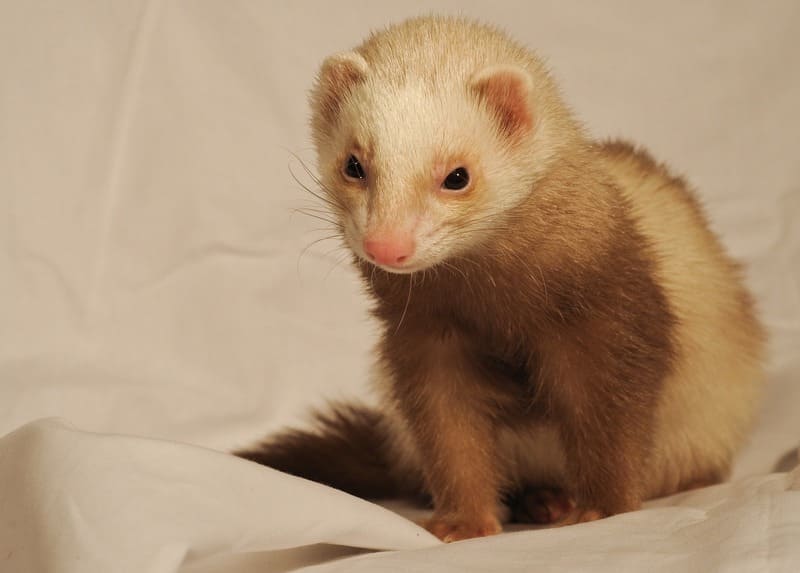Ferrets are known for their playful and curious nature, making them endearing and entertaining pets. If you’re considering adding a ferret to your family, you might wonder how they’ll get along with your other pets. In this comprehensive guide, we’ll explore the compatibility of ferrets with various common household pets, offer tips for successful introductions, and provide guidance on ensuring a harmonious multi-pet environment.

Ferrets and Dogs
Ferrets and dogs can develop positive relationships, but their compatibility depends on the individual personalities of both the ferret and the dog. Here are some factors to consider when introducing a ferret to a dog:
1. Size and Temperament
Smaller dog breeds are generally more compatible with ferrets, as they pose less physical risk. Dogs with calm and gentle temperaments are more likely to coexist peacefully with ferrets.
2. Prey Drive
Dogs with a strong prey drive may view ferrets as potential prey, especially when ferrets exhibit playful or erratic movements. Breeds traditionally used for hunting, like terriers, may require more careful introductions and supervision.
3. Training
A well-trained dog is more likely to understand boundaries and respond to commands, making interactions with ferrets safer. Ensure your dog has basic obedience training and a reliable recall command.
4. Supervision
Always supervise interactions between ferrets and dogs, especially during the initial introduction phase. Use a leash for the dog and create a controlled environment to minimize the risk of accidents.
5. Separation
Provide separate living spaces for your ferrets and dogs to ensure the safety and well-being of both pets. Ferrets need their enclosure, and dogs should have their designated area.
6. Positive Associations
Foster positive associations between your dog and ferret by offering rewards and praise when they exhibit calm and respectful behavior around each other. This can help your pets learn to coexist more peacefully.
7. Slow Introductions
Introduce your ferret and dog gradually, allowing them to become accustomed to each other’s scents and presence before allowing direct interactions. Over time, increase the duration of their interactions while closely monitoring their behavior.
8. Respect Individual Preferences
Remember that not all ferrets and dogs will get along, and it’s crucial to respect their individual preferences. If they show signs of stress, aggression, or discomfort, consider keeping them separate.

Ferrets and Cats
Ferrets and cats can have positive relationships, but their compatibility depends on the personalities and temperaments of the individual animals. Here are some considerations for introducing ferrets to cats:
1. Age and Socialization
Young cats and kittens may be more accepting of ferrets, especially if they have been socialized with other animals from a young age. Older and less social cats may be less accepting.
2. Prey Drive
Cats have a natural instinct to chase and hunt, and some may view ferrets as prey. Cats with high prey drives may require more cautious introductions and ongoing supervision.
3. Supervision
Always supervise interactions between ferrets and cats, especially during the initial introduction period. Be prepared to intervene if necessary.
4. Introduction Process
Start the introduction by allowing the animals to become familiar with each other’s scent through closed-door interactions. Gradually allow them to see each other through a baby gate or crate to gauge their reactions. When introducing them face to face, keep both animals on a leash or in carriers to maintain control.
5. Positive Associations
Use positive reinforcement to create a sense of security and comfort during interactions. Offer treats and praise when both animals exhibit calm and respectful behavior around each other.
6. Separate Living Spaces
Ensure that both your ferrets and cats have separate living spaces to prevent any potential stress or conflicts. This allows each pet to have their designated safe haven.
7. Individual Personalities
Every ferret and cat is unique. Some may become fast friends, while others may coexist peacefully but not interact much. Understanding and respecting their individual preferences is essential.

Ferrets and Birds
Ferrets and birds are not typically compatible pets due to the predatory nature of ferrets. Ferrets have a strong hunting instinct and might pose a threat to birds, especially smaller species like budgerigars or canaries. Keeping ferrets and birds in the same household is generally not recommended for the safety of the birds.
If you have both ferrets and birds, it’s crucial to keep them in separate, secure enclosures. Ensure that your ferrets cannot access the area where the birds are kept. Always prioritize the safety and well-being of your feathered friends by keeping them out of reach of the ferrets.
Ferrets and Other Small Mammals
Ferrets tend to get along well with other small mammals, such as guinea pigs, rabbits, and hamsters, as long as proper introductions and supervision are in place. Here are some tips for introducing ferrets to other small mammals:
1. Separate Enclosures
Keep your ferrets and small mammals in separate enclosures to ensure their safety. Ferrets have a strong hunting instinct, and even if they don’t intend harm, their play can be overwhelming for smaller animals.
2. Supervision
When allowing interactions between ferrets and small mammals, closely supervise their playtime. Ensure that the smaller animals have a place to retreat to if they feel overwhelmed.
3. Positive Associations
Use positive reinforcement during interactions by offering treats and praise to encourage calm and respectful behavior. Gradually increase the duration of their interactions over time.
4. Individual Personalities
Consider the individual personalities of your ferrets and small mammals. Some ferrets may be more gentle and less interested in hunting, while others may have a stronger prey drive.
Ferrets and Other Ferrets
Ferrets are highly social animals and tend to get along well with other ferrets. In fact, many ferret owners choose to have more than one ferret to provide companionship and prevent loneliness. Here are some considerations for keeping multiple ferrets:
1. Same-Gender Groups
It’s generally recommended to keep same-gender groups of ferrets, as opposite-gender pairs can lead to unwanted litters unless one or both ferrets are neutered.
2. Age and Temperament
When introducing a new ferret to your existing group, consider the ages and temperaments of all the ferrets involved. Younger ferrets may be more energetic and playful, while older ones may prefer a quieter environment.
3. Slow Introduction
Introduce new ferrets to your existing group gradually, allowing them to get used to each other’s presence and scents before direct interactions. Always supervise introductions and be prepared to intervene if necessary.
4. Separation When Needed
Sometimes, not all ferrets will get along perfectly. If you have a particularly aggressive or dominant ferret, it may be necessary to separate them from the group to prevent conflicts.
5. Group Dynamics
Each group of ferrets will have its own unique dynamics. While most ferret groups get along well, it’s important to be flexible and adapt to the needs and preferences of your ferrets.

General Tips for Multi-Pet Households
Regardless of the specific pets you have in your household, there are some general tips that can help create a harmonious and safe environment for all your pets:
1. Proper Introductions
When introducing a new pet to the household, take it slow. Allow the animals to become familiar with each other’s scent first, and then gradually progress to visual interactions. Be patient and prepared for the process to take time.
2. Supervision
Always supervise interactions between pets, especially during the initial stages of introduction. Be ready to intervene if you notice signs of stress, aggression, or fear in any of your pets.
3. Safety Measures
Ensure that all enclosures and living spaces are secure. This is especially important when you have pets with different needs and behaviors. Make sure each pet has a safe and separate area where they can retreat to if needed.
4. Training and Socialization
Training your pets is key to creating a harmonious household. Teach them basic commands and behaviors that promote respect and obedience. Socializing your pets with different people and animals from an early age can also improve their adaptability.
5. Positive Associations
Encourage positive associations between pets by offering rewards and praise when they exhibit calm and respectful behavior around each other. Positive reinforcement can help reduce tension and create a more relaxed atmosphere.
6. Individual Attention
Remember to provide individual attention and care to each of your pets. While group interactions are important, spending quality one-on-one time with each pet helps strengthen your bond and meet their unique needs.
7. Consider Species Needs
Be mindful of the specific needs of each species. Different pets have varying dietary, exercise, and environmental requirements. Ensuring that these needs are met contributes to their overall well-being.
8. Veterinary Care
Regular veterinary check-ups are crucial for all your pets. Schedule wellness exams, vaccinations, and preventive care as recommended by your veterinarian.
Signs of Stress and Conflict
Understanding the signs of stress and conflict in your pets is essential for maintaining a harmonious multi-pet household. Here are some common signs to watch for:
- Aggressive Behavior: Aggression, such as growling, hissing, or biting, is a clear sign of conflict.
- Fear or Avoidance: If one pet is constantly avoiding or fleeing from another, it indicates discomfort or fear.
- Changes in Eating or Drinking Habits: Sudden changes in appetite or water consumption may be signs of stress.
- Excessive Grooming: Pets may groom excessively when stressed, leading to fur loss or skin irritation.
- Hiding: Pets that hide or seek refuge often do so because they feel threatened or anxious.
- Vocalization: Excessive barking, meowing, or other vocalizations can indicate distress.
- Litter Box or House Soiling: Inappropriate elimination may occur when pets are stressed or anxious.
- Destructive Behavior: Chewing, scratching, or digging behaviors may increase in stressed pets.
If you notice any of these signs, it’s crucial to address the issue promptly and take steps to reduce stress and conflicts.
Conclusion
Ferrets can get along with other pets, but the success of these relationships depends on various factors, including the personalities of the individual animals, their socialization, and their training. Whether you have dogs, cats, birds, other small mammals, or additional ferrets, careful introductions, supervision, and positive reinforcement can help foster harmonious interactions.
Remember that every pet is unique, and some may have strong prey drives or personalities that make them less compatible with ferrets. Always prioritize the safety and well-being of your pets when considering multi-pet households, and be prepared to make adjustments and accommodations to ensure everyone’s happiness and comfort.
